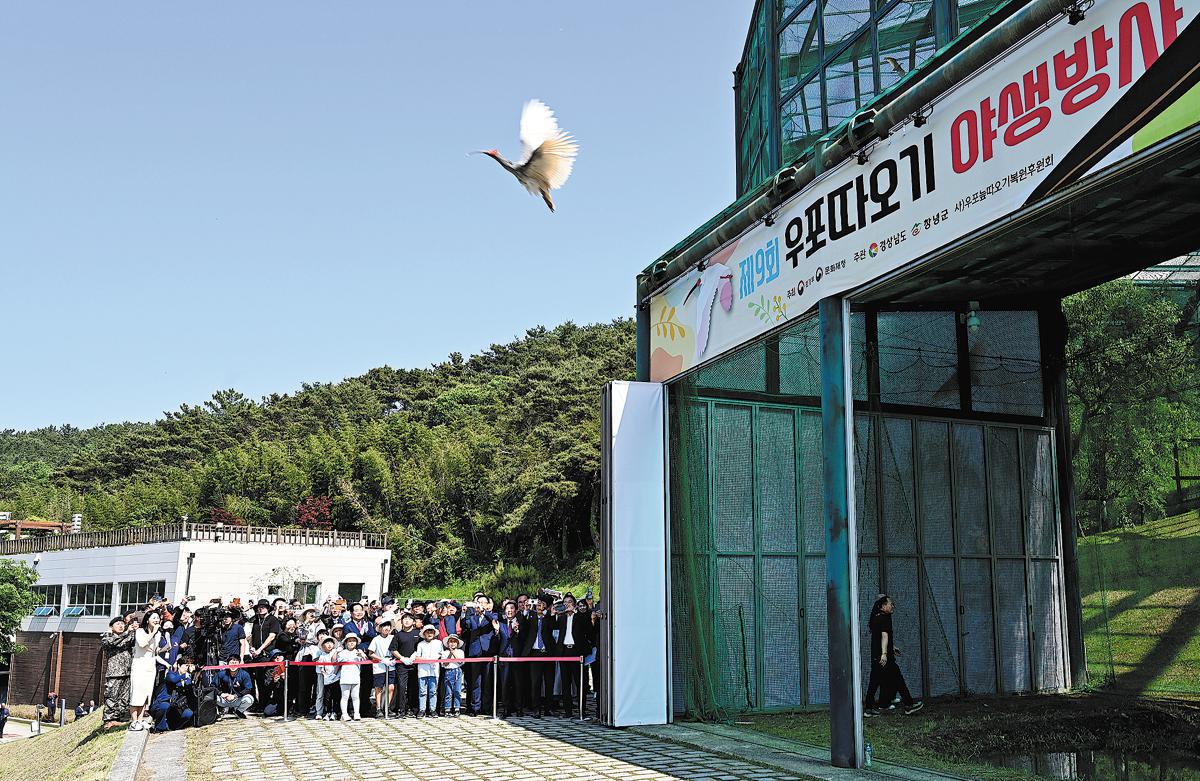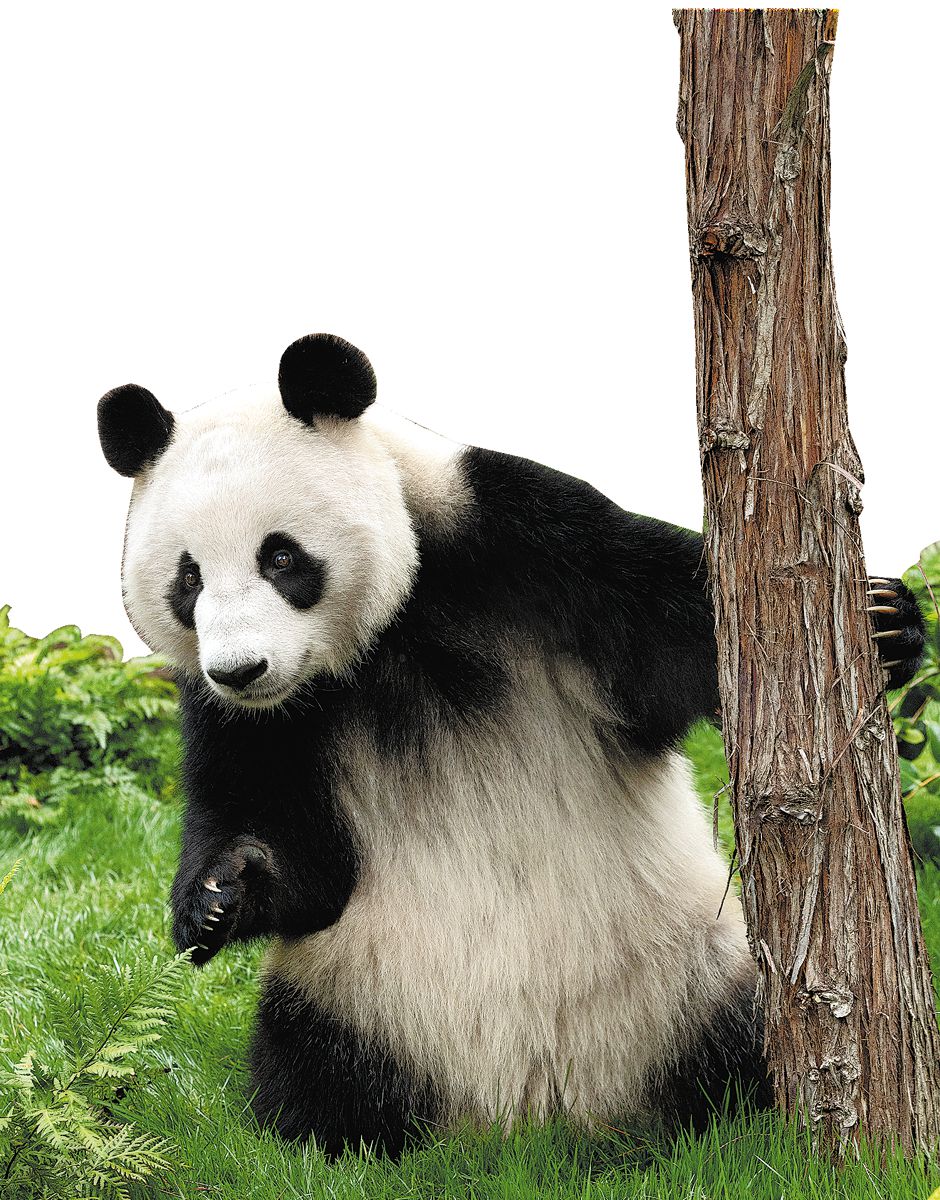From crested ibises to pandas, China lights conservation path

Tourists take photos of giant panda Ru Yi at the Moscow Zoo in Moscow on July 31. (Cao Yang/Xinhua)
As a country rich in wildlife species, China has provided significant support for biodiversity conservation and promoting global ecological development, officials and experts said.
"China emphasizes the construction of ecological civilization, and has made joint efforts to build a community with a shared future for mankind — strengthening wildlife protection and international cooperation that is crucial to that process," said Wang Weisheng, director of the flora and fauna department at the National Forestry and Grassland Administration.
Wang said China's restoration of the once nearly extinct crested ibis population is a "successful model for saving endangered species worldwide".
In recent decades, by providing genetic resources and technical guidance, China has supported Japan and South Korea in restoring crested ibis populations in the wild.
Crested ibises were once widely distributed across East Asia, but were believed to have disappeared from the Korean Peninsula, Japan, and other areas by the 20th century.
In 1981, wildlife experts discovered seven crested ibises in the Qinling Mountains in Northwest China's Shaanxi province. China later gifted several of the birds to Japan and South Korea to assist in saving their populations.

A tourist wears her self-made T-shirt with patterns of the panda pair at the San Diego Zoo on Aug 8. (Zeng Hui/Xinhua)
The known global crested ibis population now exceeds 10,000, and all are believed to be descendants of the seven found in the Qinling Mountains, according to the management bureau of the Hanzhong Crested Ibis National Nature Reserve.
Through collaborative breeding and research efforts with China, Japan's crested ibis population has reached 693. The Japanese Ministry of the Environment has downgraded the crested ibis' status on the country's Red List of Endangered Species from "extinct in the wild" to "critically endangered".
In South Korea, more than 500 crested ibises have been bred at a center. More importantly, the birds have been reintroduced into the wild in all three countries, the forestry and grassland administration said.
Wang said China has also helped with the recovery of the Gobi bear population. In August, researchers from the Chinese Academy of Forestry said they had recently spotted a Gobi bear in Northwest China's Xinjiang Uygur autonomous region, marking the first recorded sighting of the endangered species in China.
In 2018, China and Mongolia signed an agreement on the implementation of a technical assistance project to save the Gobi bears and improve their range. Through six years of continuous monitoring and protection efforts, the Gobi bear population has grown from 20 to exceeding 50, said a member of the research team.
For 12 years, China has also organized wildlife protection and compliance training courses and workshops for wildlife conservation officers in developing countries in Asia and Africa to enhance their protection capabilities, he said.
However, among all these international wildlife protection efforts, the most fruitful and globally recognized is the conservation and breeding of giant pandas.

A crested ibis is released into the wild at the Upo Crested Ibis Restoration Center in Changnyeong, South Korea, on May 10. Changnyeong has taken more protective measures in its rural areas where these birds live. (Photo/Xinhua)
Envoy of friendship
Giant pandas Xing Qiu and Yi Lan departed Sichuan province for South Australia on Dec 14, taking the total number of giant pandas sent overseas last year to 10.
The pair replaced Wang Wang and Fu Ni, who were sent home in November after arriving at the Adelaide Zoo in late 2009.
Since 1994, China has engaged in giant panda conservation research cooperation with 26 institutions in 20 countries, with 71 cubs born overseas.
At present, 44 giant pandas are residing abroad, including 15 countries such as the United States, Japan, and Spain. As a symbol of friendship, the national animal receives a lot of love from people all around the world.
"From young to old, everyone who visits our Bamboo Forest falls in love with Wang Wang and Fu Ni," said Zoos SA (South Australia) chief executive Elaine Bensted in 2019, when announcing the pair of pandas were to stay in Australia for another five years.
"They are always a delight to watch, whether they're exploring their habitat, laying in the sun, climbing trees, or eating bamboo."
According to cooperation agreements signed by China and other countries, giant pandas usually stay overseas for 10 years. Cubs born during that period are returned to China before the age of 4.
Wang Wang and Fu Ni were the first giant pandas to reside in the Southern Hemisphere.
"We look forward to continuing to help giant panda conservation and gain a better understanding of pandas living in the Southern Hemisphere," said Phil Ainsley, then director of life sciences at Adelaide Zoo, adding that the agreement offered an opportunity to contribute to global panda research.
Giant pandas, an endemic species in China, are revered as a national treasure. In 2016, the International Union for Conservation of Nature revised the status of giant pandas from "endangered" to "vulnerable", highlighting the achievements of China's conservation efforts.
The wild population of giant pandas in China has significantly increased over the past 40 years, growing from around 1,100 in the 1980s to approximately 1,900 today. The global captive population of giant pandas has now reached 757, according to the National Forestry and Grassland Administration.
"We look forward to new rounds of international cooperation between China and other countries for giant panda conservation, which will further expand the scientific research achievements in the protection of giant pandas and other endangered species, and promote people-to-people connectivity and friendly exchanges," Foreign Ministry spokeswoman Mao Ning said in February.
Since the 1990s, China has engaged in exchanges with 20 countries on giant panda conservation, playing a unique and positive role in promoting friendly interactions among people and spreading China's concept of ecological civilization, said Wang Weisheng, director of the department of wildlife conservation at the administration.
"For over 20 years, we have cooperated with these countries to tackle a series of technical challenges in giant panda conservation, breeding, disease prevention and control, and reintroduction into the wild, providing strong support for the protection of giant pandas and other wildlife in their natural habitats," he said.
"This has become a model for international cooperation in the conservation of endangered wildlife."

Xin Bao plays at her new home at the San Diego Zoo in San Diego, California, the United States, in July. Giant pandas Xin Bao and Yun Chuan arrived at the San Diego Zoo from China in June. (Photo/Xinhua)
Captive breeding advances
One of the most significant achievements was the breakthrough at the beginning of this century in addressing the three major challenges of captive giant panda breeding — estrus, mating, and cub survival.
"This breakthrough significantly improved the reproductive capacity and quality of the captive giant panda population. Now, 75 percent of breeding-age female giant pandas and half of breeding-age male giant pandas have produced offspring," said Li Desheng, an expert at the China Conservation and Research Center for the Giant Panda based in Sichuan.
The focus of the next round of cooperation will be prevention and control of major diseases affecting giant pandas, protection of habitats, enhancement of survey and monitoring capabilities, and support for the establishment of the China Giant Panda National Park, according to the China Wildlife Conservation Association.
Affected by the pandemic, the international transfer and return of giant pandas have seen delays in recent years.
The year 2024, however, has seen a very active international movement of pandas. More than 20 giant pandas have returned to China after concluding their stays overseas, while 10 giant pandas have embarked on new lives overseas.
In April, Jin Xi and Zhu Yu moved to the Madrid Zoo in Spain after a family of five giant pandas returned from there to China in February.
Spain was one of the earliest countries to establish a connection with giant pandas. As early as 1978, King Juan Carlos I made his first state visit to China, during which China gifted Spain a pair of giant pandas, Shao Shao and Qiang Qiang. In 1982, Shao Shao gave birth to a cub named Zhu Lin, causing a sensation across Europe.
In 2007, the two countries signed an agreement on an international cooperation project for giant panda conservation and research.
Over the past 17 years, the two countries have collaborated to breed six giant panda cubs, making Spain the most prolific country in Europe in terms of international cooperation in giant panda breeding.
Last year, two pairs of giant pandas embarked on their journeys to the US. One pair was sent to the Smithsonian National Zoological Park in Washington DC and the other to the San Diego Zoo in California.
In November 2023, President Xi Jinping, while addressing a welcome banquet jointly hosted by friendly communities in San Francisco, said that pandas have long been envoys of friendship between the Chinese and US peoples. China is ready to continue with cooperation with the US on panda protection, he said.
Photos
Related Stories
Copyright © 2025 People's Daily Online. All Rights Reserved.









